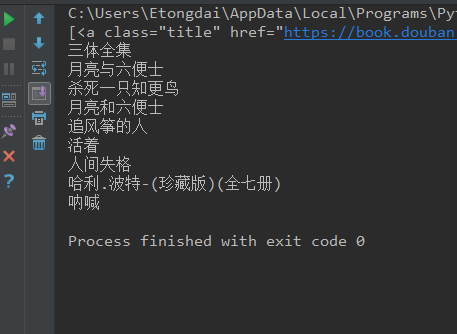Beautiful Soup模块
Beautiful Soup 是一个可以从HTML或XML文件中提取数据的Python库,它能够通过你喜欢的转换器实现惯用的文档导航,查找,修改文档的方式.Beautiful Soup会帮你节省数小时甚至数天的工作时间.
快速开始,以如下html作为例子.
html_doc = """ <html><head><title>The Dormouse's story</title></head> <body> <p class="title"><b>The Dormouse's story</b></p> <p class="story">Once upon a time there were three little sisters; and their names were <a href="http://example.com/elsie" class="sister" id="link1">Elsie</a>, <a href="http://example.com/lacie" class="sister" id="link2">Lacie</a> and <a href="http://example.com/tillie" class="sister" id="link3">Tillie</a>; and they lived at the bottom of a well.</p> <p class="story">...</p> """
使用BeautifulSoup解析这段代码,能够得到一个 BeautifulSoup 的对象,并能按照标准的缩进格式的结构输出:
from bs4 import BeautifulSoup soup = BeautifulSoup(html_doc,'html.parser') print(soup.prettify()) <html> <head> <title> The Dormouse's story </title> </head> <body> <p class="title"> <b> The Dormouse's story </b> </p> <p class="story"> Once upon a time there were three little sisters; and their names were <a class="sister" href="http://example.com/elsie" id="link1"> Elsie </a> , <a class="sister" href="http://example.com/lacie" id="link2"> Lacie </a> and <a class="sister" href="http://example.com/tillie" id="link3"> Tillie </a> ; and they lived at the bottom of a well. </p> <p class="story"> ... </p> </body> </html>
几个简单的浏览结构化数据的方法:
#打印出title标签的信息
soup.title <title>The Dormouse's story</title> #打印出title标签的标签名称 soup.title.name 'title' #打印出title标签的内容 soup.title.string "The Dormouse's story" #打印出title标签的内存地址 soup.title.strings <generator object _all_strings at 0x0000025B5572A780> #打印出title标签的父标签 soup.title.parent.name 'head' #打印出第一个p标签的信息 soup.p <p class="title"><b>The Dormouse's story</b></p> #取出p标签的值 soup.p['class'] 或者soup.p.get('class') ['title'] #打印出第一个a标签的信息 soup.a <a class="sister" href="http://example.com/elsie" id="link1">Elsie</a> #获取所有的a标签,返回一个列表. soup.find_all('a') [<a class="sister" href="http://example.com/elsie" id="link1">Elsie</a>, <a class="sister" href="http://example.com/lacie" id="link2">Lacie</a>, <a class="sister" href="http://example.com/tillie" id="link3">Tillie</a>] #返回id=link3的的标签内容 soup.find(id='link3') <a class="sister" href="http://example.com/tillie" id="link3">Tillie</a>
从文档中找到所有<a>标签的链接:
for link in soup.find_all('a'): print(link.get('href')) http://example.com/elsie http://example.com/lacie http://example.com/tillie
从文档中获取所有文字内容:
print(soup.get_text()) The Dormouse's story The Dormouse's story Once upon a time there were three little sisters; and their names were Elsie, Lacie and Tillie; and they lived at the bottom of a well.
获取标签属性
soup.a.attrs {'id': 'link1', 'class': ['sister'], 'href': 'http://example.com/elsie'}
使用BeautifulSoup库的 find()、findAll()和find_all()函数
在构造好BeautifulSoup对象后,借助find()和findAll()这两个函数,可以通过标签的不同属性轻松地把繁多的html内容过滤为你所想要的。
这两个函数的使用很灵活,可以: 通过tag的id属性搜索标签、通过tag的class属性搜索标签、通过字典的形式搜索标签内容返回的为一个列表、通过正则表达式匹配搜索等等
基本使用格式:
通过tag的id属性搜索标签
t = soup.find(attrs={"id":"aa"})
搜索a标签中class属性是sister的所有标签内容
t= soup.findAll('a',{'class':'sister'})
find_all() 方法搜索当前tag的所有tag子节点,并判断是否符合过滤器的条件.
soup.find_all("title") # [<title>The Dormouse's story</title>] soup.find_all("p", "title") # [<p class="title"><b>The Dormouse's story</b></p>] soup.find_all("a") # [<a class="sister" href="http://example.com/elsie" id="link1">Elsie</a>, # <a class="sister" href="http://example.com/lacie" id="link2">Lacie</a>, # <a class="sister" href="http://example.com/tillie" id="link3">Tillie</a>] soup.find_all(id="link2") # [<a class="sister" href="http://example.com/lacie" id="link2">Lacie</a>]
BeautifulSoup的使用
在用requests库从网页上得到了网页数据后,就要开始使用BeautifulSoup了。
一个示例:
#!/usr/bin/python #coding:utf-8 import requests from bs4 import BeautifulSoup url = requests.get("http://www.douban.com/tag/%E5%B0%8F%E8%AF%B4/?focus=book") #获取页面代码 #print(url.text) #创建BeautifulSoup对象 soup = BeautifulSoup(url.text,"html.parser") #print(soup.prettify()) #book_div 查找出div标签中id属性是book的内容 book_div = soup.find('div',{'id':'book'}) #print(book_div) #book_div的另一种写法,获取结果一样 # book_div = soup.find(attrs={"id":"book"}) # print('book_div的内容',book_div) #通过class="title"获取所有的book a标签 book_a = book_div.findAll(attrs={"class":"title"}) print(book_a) # # for循环是遍历book_a所有的a标签,book.string是输出a标签中的内容. for book in book_a: print(book.string)
执行结果:

参考文档: https://www.cnblogs.com/sunnywss/p/6644542.html
https://www.cnblogs.com/dan-baishucaizi/p/8494913.html
http://www.cnblogs.com/hearzeus/p/5151449.html
https://beautifulsoup.readthedocs.io/zh_CN/v4.4.0/



